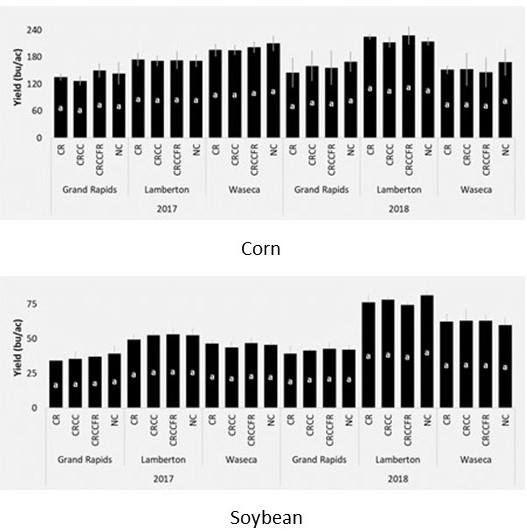Principal Investigator: Axel Garcia y Garcia and Jeff Strock
Organization: University of Minnesota, Southwest Research and Outreach Center
Award Amount: $450,223
Start Date: July 1, 2016 | End Date: June 30, 2021
Project Manager: Luke Stuewe (Luke.Stuewe@state.mn.us)
FINAL REPORT is available in the Minnesota Water Research Digital Library

The goal of the project was to assess cover crop strategies in a corn–soybean rotation to increase stability, improve resource use efficiency, and minimize negative impacts to the environment. Specific objectives were to:
- Determine the effect of cover crops on water, nitrogen (N) and phosphorus (P) use in corn-soybean rotations.
- Determine the effectiveness of cover crops at reducing N and P losses via leaching.
- Assess the performance of crop models to simulate the water and N balances on corn production in Minnesota.
- Evaluate the cost-effectiveness of cover crops in rotations.
This project demonstrated that cover crops, when interseeded into standing corn and soybean in late season and terminated at least one week before planting the next cash crop, had no detrimental effects on yield.
Key Findings
- The use of resources (N, P, and water) by late interseeded cover crops is not detrimental to the productivity of corn and soybean.
- Cover crops reduced nitrate-N in the soil solution at all study sites, but results were highly variable; so much so that biomass results and its N content did not provide enough evidence to determine the strategy with the greatest potential to reduce N loss.
- Nitrate-N concentration in the soil solution was higher in the corn than in the soybean phase of the rotation.
- The potential for N loss was higher at Grand Rapids and lower at Waseca, mainly due to sandier soils at the former site and heavier soils at the latter.
- The concentration of nitrate-N in the soil solution tended to be higher in the control treatment (no cover crop), suggesting a higher potential for N loss and evidencing that cover crop can have a positive effect to the environment.
- Although the variability of our results, cover crops seem to be a promising practice to reduce loss of N, but this was not clear for P
- Observed results showed that cover crops reduced N in the soil solution by as much as 76%, whereas effects on corn yield were non-significant. However, when the same scenario was used in the crop model, the simulated results suggest up to 25% reduction in N loss and a 10% reduction in corn yield when cover crops were added to the simulation.
- Our research suggested that cover crops could increase variable costs and reduce farm profits, at least in the short run. It’s important to note that our economic analysis neither considered the possibility of N credit nor the potential environmental benefits (including enhanced soil health, biodiversity, reduction of nitrate-N in the leachate, among others) from cover crops use
Effect of cover crop strategies on yield of corn and soybean grown at three locations in Minnesota

CRCC = CR + crimson clover
CRCCFR = CR + CC + forage radish
Cover crops were interseeded into standing corn late in the season, at R5-R6 stage of development (near maturity). Vertical lines in bars denote a standard deviation of the mean. For a given crop, yield values within a location and year followed by the same letter are not significantly different (P < 0.05).
Future Research Needs
- Cover crops reduce N loss in corn-soybean agroecosystems, but work is needed to assess best management practices aiming at widening the window for growth. Specifically, planting green and delayed cash crop planting are of interest in the region and already being tested by researchers and farmers.
- Specific studies to determine the N credit from cover crops are needed. Such studies have the potential to provide recommendations for N fertilizer reduction in corn, which could boost the adoption of the practice.
- The economics of cover crops need specific work as well. Cover crop contributions to soil health, nutrients credit, and an overall value of improvement to environmental quality should be part of an economic analysis.

